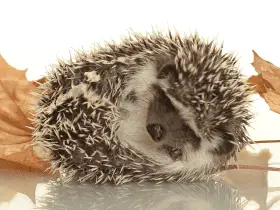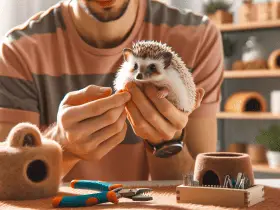Oh, the wonders of the animal kingdom! Have you ever wondered if hedgehogs have a secret life full of peculiar behaviors? Well, we’ve got news for you: they definitely do!
In this captivating article, we’ll delve into the enigmatic world of hedgehog behavior and uncover seven bizarre habits that will leave you in awe.
From self-anointing to ankle biting, these spiky little creatures are full of surprises.
So come on in, join us on this wild journey, and discover just how peculiar hedgehogs can truly be.
Key Takeaways
- Hedgehogs have unique defense mechanisms, such as self-anointing and quill popping, to protect themselves from predators.
- Understanding hedgehog behavior, such as hibernation and ankle biting, is important for their care and handling.
- Providing suitable exercise and entertainment, such as a wheel and toys, is essential for hedgehog health and well-being.
- Maintaining a balanced diet, creating a hedgehog-friendly environment, and addressing health issues, like sneezing fits, are crucial aspects of hedgehog care.
Behavior #1: Self-Anointing
Self-anointing is a strange behavior where hedgehogs cover themselves in saliva and other substances. At first, you might think it’s just another quirky habit of these prickly creatures, but there’s actually more to it than meets the eye.
Hedgehog hygiene is crucial for their overall well-being, and self-anointing plays an essential role in maintaining cleanliness.
Believe it or not, this peculiar behavior serves as one of their natural defense mechanisms. When a hedgehog encounters a new scent or taste, they begin the process of self-anointing to protect themselves from potential threats.
By covering themselves in saliva mixed with foreign substances like leaves or insects, they create a unique odor that not only masks their own scent but also confuses predators.
It’s almost like they’re playing hide-and-seek with danger! This clever tactic allows them to blend into their surroundings and reduce the chances of becoming someone’s dinner. It’s fascinating how evolution has equipped these adorable little creatures with such ingenious survival strategies.
Behavior #2: Quill Popping
When hedgehogs are threatened, we quickly contract our muscles, causing our quills to pop out as a defense mechanism. It’s like having an instant armor that says, ‘Back off!’
But what happens after the quill shedding? Well, let us tell you about the fascinating process of quill regrowth.
After the initial scare, when we feel safe again, our bodies start working their magic. The first step is to grow new quills from specialized hair follicles called ‘quill follicles.’ These follicles are located in our skin and produce both soft fur and sharp quills. Isn’t nature amazing?
The regrowth process usually takes several weeks or even months depending on various factors like age and overall health. During this time, we might look a little patchy with some areas still lacking full coverage of fresh quills. But fear not! Our bodies are hard at work ensuring that each tiny spike grows back stronger and sharper than before.
Behavior #3: Hedgehog Hibernation
During hibernation, hedgehogs enter a deep sleep where their body temperature drops significantly and their metabolic rate slows down. It’s like they’re living in their own cozy little world, snuggled up and saving energy for the springtime. But there’s more to hedgehog hibernation than meets the eye! Here are some fascinating facts about this peculiar behavior:
Hedgehog torpor: When temperatures drop, hedgehogs go into a state of torpor. This is a temporary period of decreased activity and lowered body temperature that helps them conserve energy and survive during harsh winter conditions.
Hedgehog brumation: Unlike true hibernators who sleep continuously throughout winter, hedgehogs experience periods of waking during brumation. They may venture out of their nests to search for food or even engage in some light exploring before returning to their slumber.
Energy-saving mode: During hibernation, hedgehogs slow down their heart rate and breathing to conserve energy. This enables them to make the most out of limited fat stores and survive without much sustenance.
Super-insulated nests: Hedgehogs build elaborate nests made from leaves, twigs, and other natural materials. These nests provide excellent insulation against the cold weather and help keep them warm and cozy throughout winter.
Hedgehog hibernation is truly an amazing adaptation that allows these adorable creatures to endure the toughest winters while they dream about warmer days ahead. So, next time you see a hedgehog curled up in its nest during wintertime, remember just how remarkable their hibernating abilities are!
Behavior #4: Ankle Biting
If you’re not careful, hedgehogs may surprise you with their ankle biting behavior! These adorable little creatures might seem harmless at first glance, but don’t let their prickly exterior fool you. Hedgehogs can have a mean bite!
Now, before you start panicking and second-guessing your decision to adopt a hedgehog as a pet, let’s dive into why they exhibit this ankle biting behavior. Like any animal, hedgehogs have aggression triggers that can set them off. It could be fear, stress, or simply feeling threatened. Understanding these triggers is crucial in managing their behavior.
Fortunately, there are training techniques that can help curb this ankle biting tendency. One effective technique is positive reinforcement. Rewarding good behavior with treats or praise helps the hedgehog associate positive outcomes with calmness and non-aggressive actions.
Another technique is socialization. By gradually exposing your hedgehog to different people and situations from an early age, they become more comfortable and less likely to resort to biting.
Remember, patience is key when dealing with any animal’s behavior issues. With consistent training and love, you can help your hedgehog overcome their ankle biting tendencies and create a harmonious bond between the two of you.
Behavior #5: Wheel Obsession
To help manage your hedgehog’s wheel obsession, it’s important to provide them with a suitable wheel that is safe and properly sized for their needs. We understand that our prickly friends can get quite carried away with their exercise habits, but fear not! We have some tips to keep things under control and ensure your hedgehog gets the proper exercise they need:
Choose the right size: Make sure the wheel is big enough for your hedgehog to run comfortably without arching their back. A wheel diameter of at least 12 inches is generally recommended.
Safety first: Opt for wheels with solid surfaces to prevent any potential foot or leg injuries. Avoid wire or mesh wheels that could trap tiny toes!
Keep it quiet: Look for wheels with noise-reducing features or use lubricants specifically designed for pet wheels. Your hedgehog will appreciate a peaceful workout session.
Mix it up: While running on a wheel provides great exercise, don’t forget to offer other forms of stimulation like toys and tunnels. Variety keeps things interesting!
So, dear hedgehog enthusiasts, let’s give our little buddies the perfect setup for their daily workouts while keeping them safe and entertained.
Happy hedgehog wheel running!
Behavior #6: Sneezing Fits
When your hedgehog starts having sneezing fits, it’s important to monitor their behavior and check for any signs of illness. We know how much you care about your spiky companion, and we want to help you understand why these sneezing fits may be happening.
One possible cause of sneezing fits in hedgehogs is allergies. Just like humans, our quilled friends can develop allergies to certain substances in their environment. Dust, pollen, or even certain types of bedding could trigger an allergic reaction in your hedgehog, leading to those adorable little sneezes.
Another potential cause of sneezing fits could be a respiratory infection. If your hedgehog has been exposed to other sick animals or has recently undergone stress or changes in its environment, it may be more susceptible to respiratory issues.
So what can you do? First and foremost, consult with a veterinarian who specializes in exotic animals. They will be able to examine your hedgehog and determine the underlying cause of the sneezing fits. In the meantime, try keeping their living area clean and free from dust or allergens that may exacerbate their symptoms.
Behavior #7: Puffing Up
When your hedgehog puffs up, it’s a natural defense mechanism that they use to protect themselves from perceived threats. It may seem odd or comical at first, but there are actually some fascinating reasons behind this behavior. Let us enlighten you with the causes and benefits of puffing up!
Causes of puffing up:
Feeling threatened: Hedgehogs have a strong instinct to defend themselves when they sense danger nearby.
Predatory instincts: Puffing up makes them appear larger and more intimidating to potential predators.
Stress or discomfort: In unfamiliar or uncomfortable situations, hedgehogs might resort to puffing up as a way to cope.
Benefits of puffing up:
Protection from harm: By expanding their spines and creating a barrier around their bodies, hedgehogs can deter attackers effectively.
Increased visibility: When puffed up, hedgehogs are more noticeable in their surroundings, making it harder for predators to sneak up on them.
Self-confidence boost: Puffing up gives hedgehogs an air of confidence, helping them assert dominance in certain situations.
Warning signal: The sight of a puffed-up hedgehog serves as a clear warning to other animals that they mean business and should back off.
















Leave a Reply
View Comments